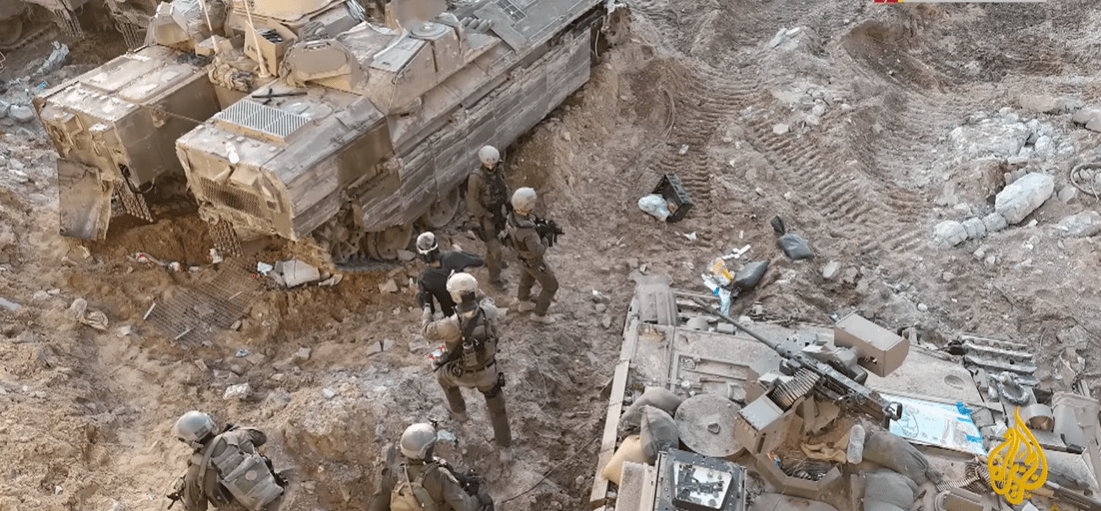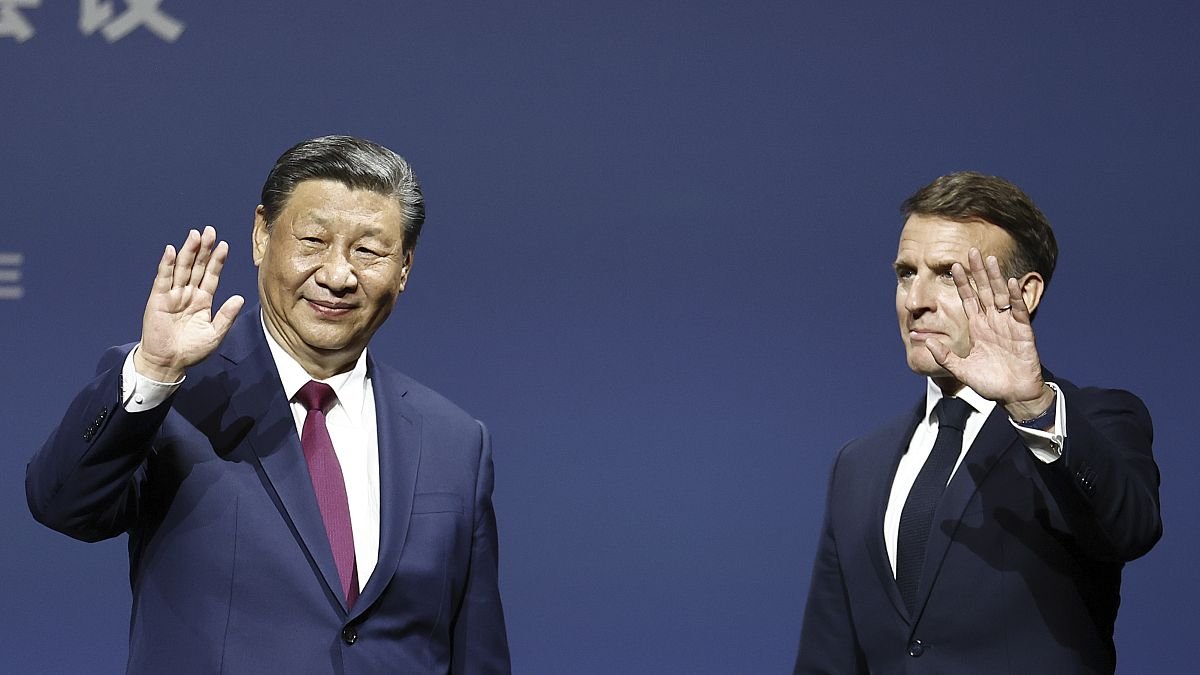
What it’s like to be used as a human shield by the Israeli army
QASEM WALEED
Surrounded by dozens of soldiers, tanks, armored cars, buzzing drones, and army dogs, Ahmad Safi found himself looking at a massive hole in the ground.
“Of all the death scenarios I have imagined myself in since the beginning of the war, I never suspected I would see my own grave,” the 26-year-old Khan Younis resident told Mondoweiss.
“Of all the death scenarios I have imagined myself in since the beginning of the war, I never suspected I would see my own grave.”
Ahmad Safi
Ahmad and his male relatives had been detained by the Israeli army and forcibly conscripted to stand in front of a resistance military base as the Israeli soldiers took cover behind them. They were caught in the middle of an exchange of fire between the soldiers and the resistance.
On the night of January 22, the Israeli army launched a sudden attack on western Khan Younis, where five shelters for displaced people were located.
In the middle of the night, the Israeli troops advanced towards the Tiba buildings, where Ahmad and his family had taken refuge in the middle of the Israeli-designated “safe zone.” These buildings were surrounded by al-Aqsa University, the al-Khair Hospital, the Industrial College, the Palestinian Red Crescent Society Center, and the al-Mawasi coastal area, all housing tens of thousands of displaced Palestinians.
Early that night, Ahmad realized that Israeli quadcopter drones had fully occupied the sky. He knew what this meant based on his accumulated experience of Israeli war tactics — the army preferred to launch major operations under cover of night.
Ahmad heard nonstop gunfire in the distance that night, but it was relatively far away, so he kept watching an anime show to distract himself.
Moments later, the sound of gunfire intensified and got closer, and suddenly he heard screams from the opposite room. His cousin had been hit by a bullet. As the gunfire started intensifying further, Ahmad threw himself under his bed when the rest of his family rushed to his room carrying his injured cousin.
That was when the Israeli soldiers stormed their apartment, bursting into the room in a blaze of flashlights.
“It was the first time I had seen an Israeli soldier in real life,” Ahmad told Mondoweiss.
The army separated the women from the men and forced the women to flee south to Rafah. The men were kept zip-tied and would remain in the army’s custody.
An Israeli commander ordered Ahmad and the men of his family to move downstairs in single file. He then ordered them to kneel against the southern wall inside their apartment, which faces a resistance military base.
Ahmad’s body was shaking uncontrollably. His lips were trembling and his breathing was heavy.
“I tried to pull myself together,” Ahmad recounted. “But when I heard my mother say goodbye to us as she was dragged outside by the Israeli soldiers, I couldn’t hold back my tears.”
“I tried to pull myself together, but when I heard my mother say goodbye to us as she was dragged outside by the Israeli soldiers, I couldn’t hold back my tears.”
Ahmad Safi
Moments later, an intensified exchange if gunfire broke out while Ahmad and his family were in between the Israeli soldiers and the resistance fighters, with no shelter. They stretched their bodies on the ground, in a helpless attempt to take cover.
“We kept screaming in Arabic, ‘stop shooting,’ and a few moments later the shooting stopped,” Ammar, another one of Ahmad’s cousins, told Mondoweiss.
They were forced to remain there for over 12 hours, conscripted by the Israeli soldiers as unwilling human shields. By the end of it, they were dehydrated and could barely stand on their feet.
At noon, in a moment of lax surveillance, Ahmad decided to perform the noon prayer with his eyes, a method that is allowed in Islam when a person is paralyzed or dying. In Ahmad’s situation, he thought, both cases applied.
Before sunset, the exchange of gunfire broke out again. Three Israeli soldiers rushed towards Ahmad and the rest of the men and pulled them toward a large sand dune, which they forced them to stand upon so that they were visible and exposed to the line of fire. As they stood atop the dune, they looked down and on the other side of it was a large ditch in the sand underfoot.
The soldiers forced them to stand there on the dune, exposed to the line of fire and with the ditch looming below.
“My cousin, Ammar, told us to cling to each other’s fingers and cross our feet, so that if a bullet hit one of us, he wouldn’t fall into that mass grave,” Ahmad told Mondoweiss.
Images of civilians being buried alive ran through their minds, exactly like they heard had happened at the Indonesian Hospital in November 2023. This was also well before news broke in April this year of the massacres and mass graves that had been uncovered at al-Shifa Hospital and Nasser Hospital, revealing hundreds of corpses.
After the exchange of fire was over, the Israeli soldiers forced Ahmad and the rest of the men inside a building. The building was all dark except for the room Ahmad and his family were forced into. The southern and eastern walls of the room were destroyed, which made those inside visible to anyone in sight from the resistance base.
Every once in a while, a soldier would come and point a red laser towards them for a few minutes, and then go away.
“I think he was trying to make it clear to the resistance fighters that we were also inside that building, as they were using us, once again, as human shields,” Ahmad explained.
Moments later, soldiers took them one by one to another room. It was the first time in more than 18 hours of being held as hostages that they began to interrogate them.
The soldiers started kicking them and insulting them as they demanded information. They forced Ahmad’s brother, Saeed, to say degrading things about himself, just so that they could laugh at him when he did.
“The intelligence command asked me to locate my house on live footage they showed me from a drone in my area,” Ahmad told Mondoweiss. “I couldn’t at first, because the whole area appeared flattened. Luckily, I located it before the second punch.”
“That was the moment I learned that my house had been destroyed,” he added.
After about two hours, the soldiers set Ahmad and his family free and ordered them to move south by making them follow a laser beam in the dead of night.
Fumbling through the roads, Ahmad and his family were finally able to reach a UN school about a mile away sheltering a number of displaced people.
“As we reached the school, and heard some people’s noise inside, we burst into tears mixed with hysterical laughter,” Ahmad said. “We couldn’t believe we survived this nightmare.”
The school was locked up, so one of them had to jump over the walls and call for someone to open up. The people there aided them with water and some bread, but Ahmad was intent on finding his uncle’s tent near the school and looking for his mother and sisters. They finally found them with his uncle.
The next morning, the entire family fled to Rafah, leaving behind everything they ever had in Khan Younis.
(Source: Mondoweiss)













